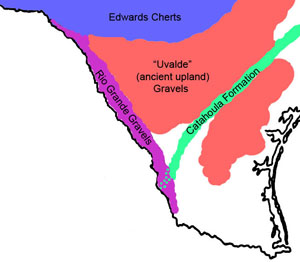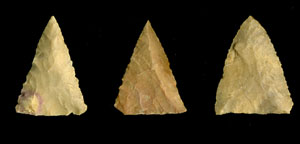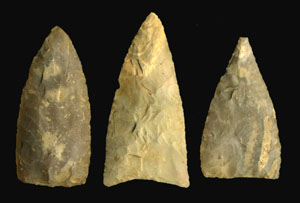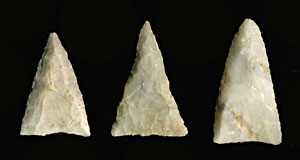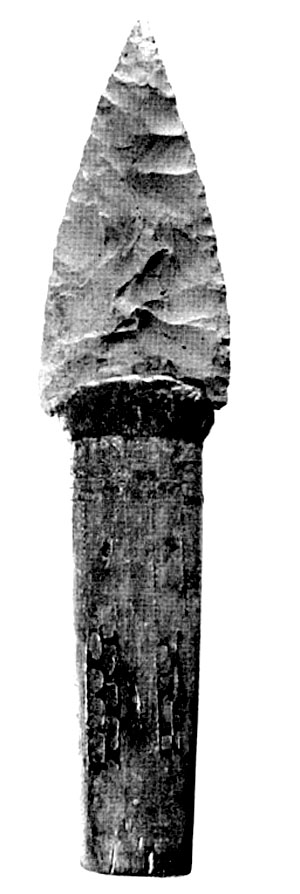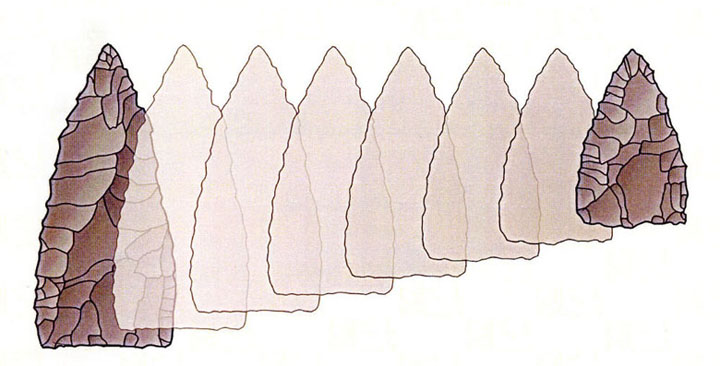 Triangular Dart Point Continuum. Cover illustration from Mahoney et al. 2002.
|
Unstemmed Point Tradition
The South Texas Plains, especially the area south and west of the Nueces River within the Rio Grande drainage basin, had a long tradition of unstemmed dart and arrow point styles. These are relatively easily made symmetrical stone tool forms ranging from triangular to tear-drop-shaped to leaf-shaped or bi-pointed in outline shape. The unstemmed point tradition is also characteristic of adjacent northeastern Mexico. Such points were made for well over 6,500 years from at least 7,000 years ago (5000 B.C.) to early historic times when the last triangular points were made by Indians living in certain of the Spanish Missions in the 1700s. This distinctive, long-lived pattern, however, poses challenges to archeological interpretation and unanswered research questions.
In most regions of Texas projectile point types and other specific stone tool forms as well as ceramic vessel types, are used as time markers and as expressions of particular cultures and geographic areas. Projectile points are particularly useful in this regard because these were made in many slightly or markedly different variations and these changed through time. Many of the differences are the result of using notching and shaping techniques to create stemmed and barbed dart and arrow points. As a group, these stemmed points have much more stylistic variability than do unstemmed points.
Archeologists have studied projectile point variation in great detail and have defined many different named types or styles. Some styles occur broadly across much of the state and sometimes far beyond, such as the Clovis point. Other styles, such as the Morhiss dart point in the eastern South Texas Plains, have localized distributions and found mainly in relatively small areas of the state. Distribution studies and radiocarbon dating have allowed archeologists to sort out where and when many styles occur. Ongoing research continues to refine this chronological and distributional knowledge toward the larger goal of understanding the underlying cultural patterns the style variations reflect.
In the southern and western stretches of the South Texas Plains and adjacent northeastern Mexico, many projectile point types and other types of stone tools are poorly correlated to specific time periods. In part this is because of the few subtantive excavations, a dearth of deeply stratified sites, and the lack of associated radiocarbon dates. Therefore, most stone tools can only be assigned to broad time periods, a problem that is made all the more difficult because of a long-lived tradition of making and using mainly unstemmed points.
Geographic Extent
The unstemmed point tradition can be said to characterize much of greater south Texas including the lower Texas coast, the Rio Grande Delta, and northeastern Mexico (adjacent parts of Tamaulipas, Nuevo Leon, and Coahuila). Within the South Texas Plains, unstemmed points make up the large majority of projectile point collections in the southern and western part of the region. Although there is no definitive boundary, south and west of the Nueces River stemless points typically make up over 60% of point collections. Along the Rio Grande, the predominance of stemless points is upwards of 90%, as several studies of several very large point collections from Webb and Starr Counties have documented. In contrast, stemmed points make up the majority of projectile points found in the northern part of the South Texas Plains along the Balcones Escarpment.
Why Stemless Points?
Why was the unstemmed tradition so prevalent in the region? While this was clearly a long-term cultural pattern that bespeaks flintknapping tradition handed down from generation-to-generation, its persistence is probably tied to the nature of the region’s lithic resources. Two factors may explain this pattern: the patchy distribution, and generally small size and uneven quality of the available stones suitable for making projectile points and bifacial knives.
Flint (chert) and other types of stones suitable for making chipped stone tools, such as chalcedony, silicified/fossilized wood, quartzite, are hard or impossible to find in some areas of south Texas. Specifically, few if any lithic sources exist in the Sand Sheet (Wild Horse Desert) and in the southern part of the coastal plain proper (south of the Nueces within 40-50 miles of the coast). Elsewhere across the region, lithic sources are relatively common, but they occur in patches and strips with large intervening chert-free areas. The main source areas are: (1) gravel bars and gravel outcrops along the major rivers draining from the Edwards Plateau (Guadalupe, San Antonio, Frio, Nueces); (2) gravel bars and gravel outcrops along the Rio Grande, which drains from a vast area far to the west; and (3) in the upland gravel deposits often referred to as the “Uvalde” gravels. See the Rock Gallery entries in Nature's Harvest.
Where suitable raw materials can be found in the southern and western South Texas Plains, they mainly occur in the form of relatively small cobbles and pebbles that are often of coarse-grained and downright tough materials that are difficult to knap. Flintknappers find such materials very challenging and have difficulty removing the kinds of large thin flakes needed as flake biface blanks for stemmed dart points as well as directly reducing cobbles into thin, stemmed dart points (core bifaces). Large, fine-grained, high-quality pieces of tool-making material are rare in the region. Over prehistoric time, the best materials would have become harder and harder to find as succeeding generations returned over and over again to pick over the same raw material source areas (“lithic procurement" areas).
We can add that upland gravels and some river gravels were probably far less accessible in prehistoric times. Today these are often easily accessed in gravel quarries, road-cuts, low-water crossings, and, especially, in eroded upland areas that have lost most of their grass cover due to livestock overgrazing. While the Nueces and Frio rivers have many accessible gravel bars, these are not as easy to find along the San Antonio and Guadalupe rivers, which still flow relatively deeply today, even with many modern demands on their waters. Due to heavy water demands and dams on both sides of the river, Rio Grande flows drastically less than it did In prehistoric times, making its gravel bars far more promenient today. In other words, the lithic resources of the South Texas Plains would have been harder to gain access to in prehistoric times.
Large dart points with carefully notched and shaped stems are very difficult to make with relatively lousy tool-making material of modest size. In contrast, on and near the Edwards Plateau, flint is plentiful and often occurs in large pieces of high quality, so it is no accident that the Plateaus and Canyonlands region was characterized by many different, finely shaped styles of stemmed dart and arrow points through time. Unstemmed points are uncommon in the central part of the state, with the exception of the dart points often referred to as Early Triangular points that date to about 5,000-6,000 years ago (3,000-4,000 B.C.) during the early Middle Archaic period.
Thus, the unstemmed point tradition of the South Texas Plains can be explained as a necessary accomodation ("adaptation") to the available raw materials. Unnotched points are relatively easy to make out of small, tough material; they are durable (in large part because they are thicker than to delicately shaped and barbed stemmed styles); and they can be resharpened fairly easily while still hafted. For highly mobile hunters, this tradition was a practical and efficient solution to life in a "lithic-challenged" area.
Sorting out the Unstemmed Point Styles of South Texas
Archeologists have tried mightily to sort out the unstemmed projectile points of south Texas into discrete and meaningful groupings or types restricted to certain time periods and/or limited geographical areas. While some success has been had, classification efforts have fallen short of the ideal for many different reasons. As said, the relatively limited number of excavations, the dearth of deeply stratified sites, and the lack of associated radiocarbon dates in the region gives us precious few solid data points. But even if we had much better data, there are other complicating factors.
Generally speaking, the earliest unstemmed dart points are relatively large, while the latest are small, thin triangular arrow points. In other words, unstemmed points became smaller and smaller (and thinner) through time. But, apart from size, there relatively few other definitive clues as to the approximate age of individual specimens. Triangular and tear-drop shaped points all have the same basic outline shapes, although there are some minor stylistic variations (straight vs. slightly concave bases, for instance). Through time, size seems to have diminished gradually rather than stepwise, as would be indicated if only narrow size ranges were characteristic of each period. And toward the end of the Archaic era, when dart points were relatively small, there really is no clear demarcation separating the smaller dart points and the larger arrow points.
There is another size factor to consider. Individual points, especially the larger dart points, became smaller and smaller during their use life as they were resharpened as tips broke and edges dulled. The need for resharpening would have been particularly critical when hunters were on the go and away from areas where raw materials could be easily found. Thus, while point size became smaller through prehistoric time, it also became smaller during the use life of an individual specimen.
And there are good reasons to suspect that the use life of individual artifacts did not always unfold in short periods of time – the span of a few months or years during which a hunter’s weapon might have been in service. Archeologists have come to realize that one of the characteristics of hunter-gatherers life was the creative adaptation of existing resources. Said more plainly, ancient peoples sometimes picked up long-abandoned stone tools and put them back in service. Some of us suspect that such recycling was much more common in the region than has been realized. See Stone Tool Recycling.
Yet another complication in sorting out unstemmed point styles is the fact that the manufacturing process by which many stemmed points are made included an unfinished stage during which the point-in-progress was an unstemmed “perform” that looked very similar to finished unstemmed points. Upon close inspection, performs typically lack the fine edge retouch characteristic of finished points. Finished points are also commonly broken by impact fractures, whereas broken performs have snap fractures and other evidence of manufacturing failures. And, finished points often have obvious indications of resharpening (such as edge beveling and other differential flake patterns). Finally, finished points that were put in service sometimes develop detectable use-wear patterns, most of which can only be seen under the microscope and require a trained eye to interpret.
One final difficulty. Hafted, pointed bifaces with sharp edges ("projectile points") can do more than bring down game. Dart points were also suitable, and often used, as cutting tools—knives, as has been demonstrated by use wear studies. Projectile points sometimes even served as tools used for scraping, drilling holes, and so on. Throughout their use lives, many “dart points” were probably used for many different tasks – projectile tips, expedient knives, expedient prods, prying tools, and the like. But the various functional uses need not concern us here. Archeologists typically classify a relatively thin pointed biface as a point whether or not it served as the head of a projectile, or a small knife, or as both.
Named Styles of Unstemmed Points from South Texas
Archeologists have defined ten types of unstemmed dart points and three types of unstemmed arrow points that commonly occur in the South Texas Plains. And this doesn’t include the unstemmed arrow point styles that are essentially restricted to the coast, including the Lozenge, McGloin, Cameron, Padre, and Starr types. To see typological descriptions and illustrations from Turner and Hester’s (1993) book, Stone Tools of Texas Indians, click on any of the below type names.
-
Triangular Dart:
- Early Triangular

- Kinney

- Matamoros

- Pandora

- Tortugas

-
Tear-Drop (rounded base ) Arrow:
- Young

It is not surprising that archeologists have tried to sort out this continuum of unstemmed points by trying to define more or less fixed types. Named types facilitate communication and are often useful for general characterizations. Yet, as some archeologists have acknowledged, the unstemmed point tradition probably reflects continuums in size and shape variation more than definitive groupings that can be demonstrated by analyses of large samples of well-dated specimens. Until and unless these sorts of analyses are possible, the validity of many of the named types is subject to question and controversy for the reasons explained. Continuums are hard to classify into neat piles.
Some types, such as the alternately edge-beveled triangular Tortugas point, do form rather distinctive and characteristic groupings. And in some areas, such as the Choke Canyon Reservoir, archeologists have made some progress in defining meaningful groupings. But it seems likely that we will never succeed in fully or even mostly sorting out unstemmed point variation into meaningful groupings that had restricted distributions in time and across geographical space. Take the example of what we might call the triangular dart point continuum.
Some progress in dating Tortugas points, and the smaller but otherwise similar Matamoros points, has been made at several tested and excavated sites with associated radiocarbon dates. Triangular dart points have been associated with radiocarbon dates starting at about 4800 B.C. (5900 radiocarbon years before present or RCYBP) and continue to at about 25 B.C. (2000 RCYBP), a span of almost 5,000 years. Acceptable radiocarbon dates have been obtained from sites in Live Oak, Zapata, and Webb Counties. Points very similar to the Tortugas points, but classified as Early Triangular points, were recovered from a discrete shell midden stratum at the McKinzie site (41NU221) on Nueces Bay that has been dated to between 4800-4200 B.C. (5900-5300 RCYBP). And at the other end of the triangular continuum across time, a site in Live Oak County (41LK106) yielded two small, thick Matamoros points in association with bone-tempered pottery, suggesting an age no older than A.D. 1000.
Thus within the overall chronological framework, triangular dart points appear to have been used in and near the South Texas Plains from the latter part of the Early Archaic through to the end of the Late Archaic and possibly even into early Late Prehistoric times. Given how little solid, well-dated evidence we have in hand of the technological transition from the Paleoindian era to the Archaic era, it can be hypothesized that the unstemmed tradition began in Clovis times and remained a characteristic of the South Texas Plains throughout aboriginal history.
In conclusion, the unstemmed point tradition of the South Texas Plains and adjacent northeastern Mexico ranks as an enduring, yet archeologically vexing, cultural pattern that is uniquely characteristic of the region. It is perhaps best explained as a functional adaptation to the available lithic resources within a mobile hunting and gathering lifestyle. It is cultural tradition that was followed for at least 6,500 years.
Attention serious students of archeology: Many of the inferences advanced here should be recognized for what they are—hypotheses and trial explanations which deserve proper scientific evaluation. Will these ideas survive as valid interpretations? Gauntlet thrown, convincing data and well-considered arguments needed.
Contributed by Steve Black and Mike Quigg.
Select References
Aveleyra Arroyo de Anda, Luis, Manuel Maldonado-Koerdell, and Pablo Martinez del Rio
1956 Cueva de la Candelaria. Memorias del Instituto Nacional de Antropologia e Historia, Mexico City.
Turner, Sue Ellen and Thomas R. Hester
1993 Stone Tools of Texas Indians. Texas Monthly Press, Austin.
Bettis, Allen C., Jr
1997 Chipped Stone Artifacts from the Killam Ranch, Webb County, Texas. TARL Research Notes 5(2):3-21.
Mahoney, R.B., R.P. Mauldin, and S.A. Tomka
2002 Archeological Data Recovery Excavations along Becerra Creek (41WB556), Webb County, Texas.
Center for Archaeological Research, Archaeological Survey Report, No. 321. University of Texas at
San Antonio.
Nunley, Parker and Thomas R. Hester
1966 Preliminary Archeolgical Investigations in Dimmit County, Texas. Texas Journal of Science 18(3):233-253.
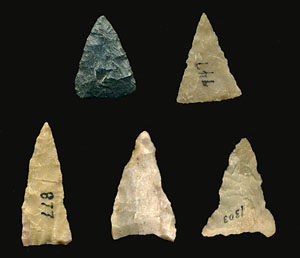
|
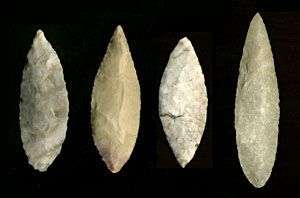
|
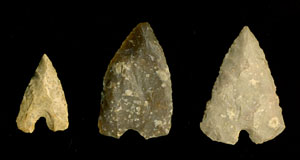
|
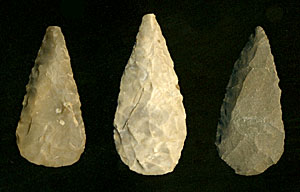
|
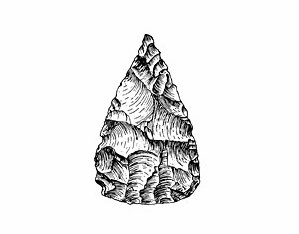
|
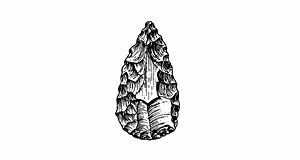
|
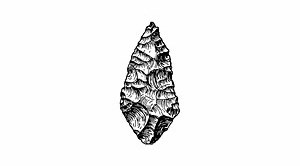
|
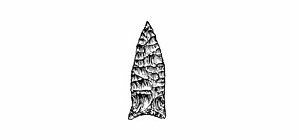
|
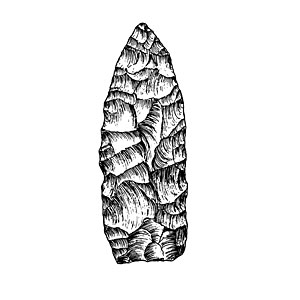
|
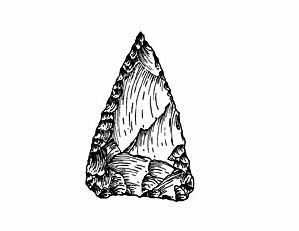
|

|
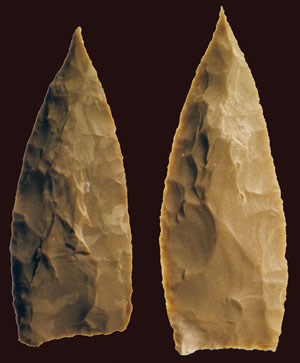
|
